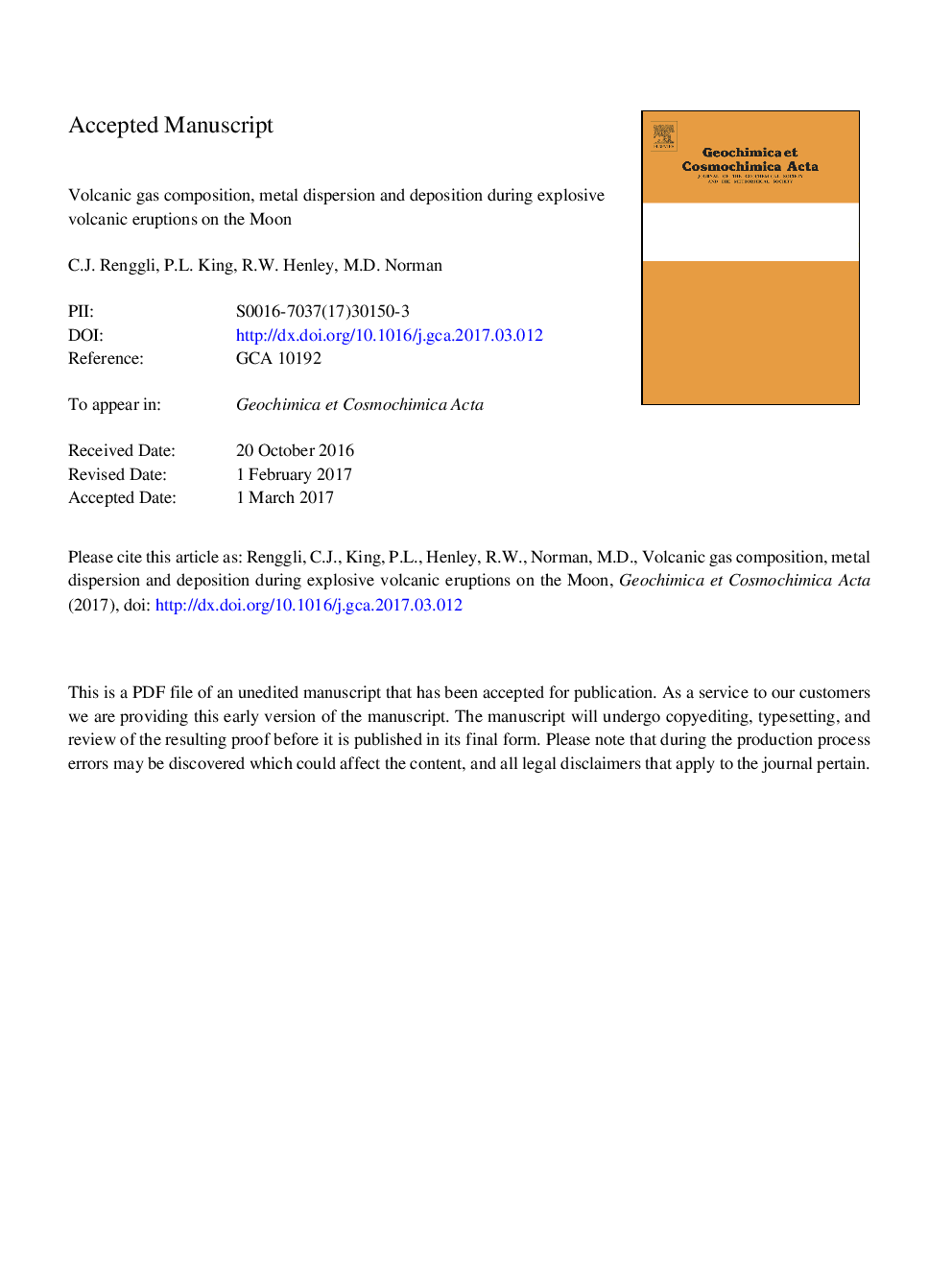| کد مقاله | کد نشریه | سال انتشار | مقاله انگلیسی | نسخه تمام متن |
|---|---|---|---|---|
| 5783425 | 1637951 | 2017 | 42 صفحه PDF | دانلود رایگان |
عنوان انگلیسی مقاله ISI
Volcanic gas composition, metal dispersion and deposition during explosive volcanic eruptions on the Moon
ترجمه فارسی عنوان
ترکیب گاز آتشفشان، پراکندگی فلزی و رسوب در فوران آتشفشان انفجاری بر روی ماه
دانلود مقاله + سفارش ترجمه
دانلود مقاله ISI انگلیسی
رایگان برای ایرانیان
کلمات کلیدی
ماه، گاز آتشفشانی ذخایر پیروکلاستی، حمل و نقل فلزی، خاصیت، پوشش سولفید،
موضوعات مرتبط
مهندسی و علوم پایه
علوم زمین و سیارات
ژئوشیمی و پترولوژی
چکیده انگلیسی
The transport of metals in volcanic gases on the Moon differs greatly from their transport on the Earth because metal speciation depends largely on gas composition, temperature, pressure and oxidation state. We present a new thermochemical model for the major and trace element composition of lunar volcanic gas during pyroclastic eruptions of picritic magmas calculated at 200-1500 °C and over 10â9-103 bar. Using published volatile component concentrations in picritic lunar glasses, we have calculated the speciation of major elements (H, O, C, Cl, S and F) in the coexisting volcanic gas as the eruption proceeds. The most abundant gases are CO, H2, H2S, COS and S2, with a transition from predominantly triatomic gases to diatomic gases with increasing temperatures and decreasing pressures. Hydrogen occurs as H2, H2S, H2S2, HCl, and HF, with H2 making up 0.5-0.8 mol fractions of the total H. Water (H2O) concentrations are at trace levels, which implies that H-species other than H2O need to be considered in lunar melts and estimates of the bulk lunar composition. The Cl and S contents of the gas control metal chloride gas species, and sulfide gas and precipitated solid species. We calculate the speciation of trace metals (Zn, Ga, Cu, Pb, Ni, Fe) in the gas phase, and also the pressure and temperature conditions at which solids form from the gas. During initial stages of the eruption, elemental gases are the dominant metal species. As the gas loses heat, chloride and sulfide species become more abundant. Our chemical speciation model is applied to a lunar pyroclastic eruption model with isentropic gas decompression. The relative abundances of the deposited metal-bearing solids with distance from the vent are predicted for slow cooling rates (<5 °C/s). Close to a volcanic vent we predict native metals are deposited, whereas metal sulfides dominate with increasing distance from the vent. Finally, the lunar gas speciation model is compared with the speciation of a H2O-, CO2- and Cl-rich volcanic gas from Erta Ale volcano (Ethiopia) as an analogy for more oxidized planetary eruptions. In the terrestrial Cl-rich gas the metals are predominantly transported as chlorides, as opposed to metallic vapors and sulfides in the lunar gas. Due to the presence of Cl-species, metal transport is more efficient in the volcanic gas from Erta Ale compared to the Moon.
ناشر
Database: Elsevier - ScienceDirect (ساینس دایرکت)
Journal: Geochimica et Cosmochimica Acta - Volume 206, 1 June 2017, Pages 296-311
Journal: Geochimica et Cosmochimica Acta - Volume 206, 1 June 2017, Pages 296-311
نویسندگان
C.J. Renggli, P.L. King, R.W. Henley, M.D. Norman,
